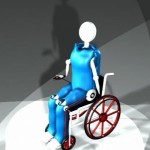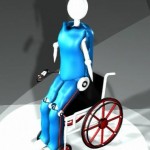Read about Wearable Robots

 Photos of the LIFESUIT Robotic Exoskeleton from the They Shall Walk Research Lab located in Seattle Washington, supported by individual donors not government funding or tax dollars.
Photos of the LIFESUIT Robotic Exoskeleton from the They Shall Walk Research Lab located in Seattle Washington, supported by individual donors not government funding or tax dollars.
Wearable Robots Help Paralyzed Warriors Walk Again (repost)
Published December 29, 2011
| FoxNews.com
Walking is one of the many things in life that most of us take for granted. Now, for those who can’t, a technological marvel could prove miraculous.
A Defense Department program to develop super-strong soldiers has led to a wearable robot that enables paraplegics to walk.
At 10 leading rehab facilities from Honolulu to Atlanta, Ekso Bionics’ Iron Man-style exoskeletons have been quietly tested over the past year, to resounding success.
Related Slideshow
Ekso Bionics Wearable Robot Helps Paraplegics Walk
A defense department program to develop super-strong soldiers leads to a wearable robot capable of helping paraplegics walk. Sound like a comic book? Nope. It’s real. Read more
Simply put, the exoskeleton is a wearable robot that allows a wheelchair user to stand up and walk. It could be a game-changer not only for wounded warriors with spinal cord injuries, but for people with multiple sclerosis, Guillain-Barre syndrome, lower extremity weakness or paralysis due to neurological disease or spinal injury.
Wheelchairs have been the go-to solution for more than 1,500 years – the 2002 census estimated 2.8 million U.S. citizens rely on them — but now Ekso Bionics is literally revolutionizing this space. Its ultimate goal: a robot that is as easy to wear as a pair of jeans, one that requires not only innovative engineering but biomechanics advancements and cyborg-type research.
“Making a robot itself is difficult enough. To add that to the body and put it on like a pair of jeans is a whole other level,” Ekso Bionics CEO Eythor Bender said at a March TEDMed conference in Long Beach, Calif.
The exoskeleton has four electric motors that replicate a person’s hips and knees. Fifteen sensors are networked with a computer that sits on the user’s back and acts as a “brain.” A battery pack provides four hours of endurance.
While users learn to walk with the exoskeleton — for some, it is quite literally their first steps — physical therapists hold a remote control to assist, support and guide them. The Ekso is designed to make the gait as natural as possible, which is particularly important for users who are relearning how to walk.
The exoskeleton can be modified to fit a person ranging from 5-foot-2 to 6-foot-2, with a maximum weight of 220 pounds. While there are some contraindications, many are capable of passing the medical screening and evaluation to use the device, the company has said.
In its current phase, a candidate must have the upper body strength to transfer from a wheelchair to a regular chair and to balance with crutches.
The next stage involves artificial intelligence and the user going solo. With that model, he’ll be able to initiate a step by leading with his arms and crutches and driving the opposite foot forward. The Ekso’s brain identifies body movement signals and converts them into movement of the exoskelton’s “hips” and “knees.”
This next generation will be available for trial within the next six months; it is currently undergoing clinical trials at the Kessler Institute.
Founded in 2005, Ekso Bionics created both the ExoHiker, which allows a user carrying up to 200 pounds to run over a range of challenging terrain, and the ExoClimber, which is designed to move the same payload up stairs and steep slopes quickly.
The Department of Defense quickly cottoned to the exoskeleton’s potential and sponsored the Human Universal Load Carrier (HULC) program. In 2009 HULC was licensed by Lockheed Martin for further military development.
HULC works without a joystick: A computer matches its movement to the direction of its user, allowing crawling, upper body lifting and deep squats while preventing lower back injuries. This past summer a ruggedized version called the HULCTM began biomechanical testing at the U.S. Army Natick Soldier Research, Development and Engineering Center in Natick, Mass.
Of course, a soldier on the hunt for a super exoskeleton has different needs than a civilian who wants to get out of a wheelchair. In collaboration with the medical partners and a design team, Ekso has been tailoring the military-inspired technology for the civilian.
Electronics replace the super soldier’s hydraulics, since civilians have lesser carrying needs. Reducing weight and making the exoskeleton smaller are ongoing design goals.
But ultimately, users require tools that can be mastered. Ekso is not quite ready to be taken home, but it’s getting close.
Ekso Bionics started collaborating with the leading U.S. rehabilitation providers and is now expanding into Europe, teaming with some of the world’s best there. In October the company demonstrated its exoskeleton at the London International Technology Show and announced that it would be available in the United Kingdom next year.
The price tag is high: The exoskeleton currently costs $150,000 — hardly ideal, but not unexpected for cutting-edge technology of this sort.
From amping the power of super soldiers to giving paraplegics back the ability to walk, Ekso Bionics is one little company that helps us remember how challenging even a “simple” task like walking can be.
Ballet dancer turned defense specialist Allison Barrie has traveled around the world covering the military, terrorism, weapons advancements and life on the front line. You can reach her at wargames@foxnews.com or follow her on Twitter @Allison_Barrie
************************************end of repost*********************************
Because of supporters like you, we have created and cultivated a new field in science. Heinlein created the exoskeleton concept in his book “Starship Troopers”
You can read about the story behind the LIFESUIT and the develpment of exoskeletons in the new book “Get STARTED-don’t quit” by Monty K Reed






